In recent years, the increase in tourism has been huge. The part of the global population which has the resources for taking time off and traveling has also increased. And more, people travel farther and for a shorter duration. Destinations and tourist tours are more standardized: some world-famous places welcome millions of visitors per year, who come from all over the world. Tourist pressure on this spot is considerable and has a very negative impact on its environment. Sometimes, entire cities and countries are concerned by this problem. This is due to the most popular way of doing tourism today: to see a maximum of places in a minimum of time during holidays.
Is it possible to do tourism in another way? How can we limit our impact on the environment if we want to travel? We are going to see that solutions exist. It’s possible to travel and to respect the place that we are visiting at the same time. To do this, first, we have to adopt good habits in all places where we come (pick up our trash, respect local traditions, respect rules and not degrade the environment around us). However, it’s also possible to completely rethink our approach to travel by examining our goals and desires regarding tourism. What precisely do we seek when we travel? Do we want to just go where everybody goes, as far as possible and and ticking off as many sights as we can? Or do we really want to enjoy the places that we are visiting and take the time to discover them?
A concept is born from this reflection. It’s called “slow travel”, or “slow tourism”. We are going to check what slow travel is and how we can all change our travel habits.
Slow tourism is sustainable tourism, as opposed to traditional tourism. For this kind of tourism, it is important to have respect for places and its residents. So, we have to change our habits and especially question our holiday wishes. The main and first thing to remember is that we have to take our time. Because the only way to really discover a destination is to visit it slowly. In this part, we will check which are the numerous advantages of this new type of more sustainable tourism.
For personal development: In taking our time (fewer visits and less kilometers), we have the possibility to really take a break during our holidays. Take time for yourself, take rest, and decrease our stress and your mental load. Holidays are for taking a break which allows you to come back to work with more energy. So, it’s important to adopt a chiller rhythm if we wish to make our holidays a really relaxing moment.
To better discover visiting places: In moving away from big sightseeing tours and staying longer in places that we are visiting, we have the possibility to really discover destinations. Because if we follow the traditional sightseeing tours, we often just see the tourist showcase, without really discovering the culture and the richness of the country. So, we have to go to different places than all other people, and especially to stop at spots that are less spectacular but more authentic. Each little village or little path hides some passionate secrets!
To meet with people better: To meet with the local community and to communicate with them is also an essential part of the trip. If we really want to meet people, to be able to have real, fascinating discussions with them and help you discover their culture, it’s important to reach out to them and especially to meet them in their living space. We also need to move away from big sightseeing tours because places used for mass tourism aren’t yet real living spaces but just used for the tourist welcome. So, to get closer to local people we have to get closer to where they live. It’s necessary to stop in the visited places and have enough time to create some links. And from the moment that people open their doors to us, the trip experience is complete.
To respect the environment: Moving away from the big sightseeing tours enables us to reduce the pressure on these places which are massively visited. Transport choice also has an impact on the environment. First, it’s better to not use the plane because its carbon impact is huge, even for just one journey. Its impact is often more important than all the rest of the trip. Cruises on big liners also have a very bad impact on the environment, because they degrade marine environments and reject a lot of CO2 in the atmosphere. When we choose to travel fewer kilometers and when we browse them more slowly, we reduce the CO2 quantity sent in the atmosphere during our trip. Practicing slow travel is also about choosing destinations and touristic services responsibly.
To save money: Choosing slow-travel impacts expenses as well, making the trip more affordable. If we reduce the travelling distances, we reduce the transport costs. Besides, moving away from the big sightseeing tours means a discount on the prices of products and services on site. Indeed, in popular tourist places prices are often higher (food, accommodations, visits…).
But what can we concretely change concerning our habits, to make our trip a “slow travel”?
Transportation: As the most important aspect, the most ecological options are trains, bicycles and walking. If we want to do an itinerant trip, cars, motorcycles, or buses can be good alternatives to planes because they pollute less. Van is also a good solution because it allows for transportation and accommodation. Using a donkey, horse, camel or another draught animal is an excellent and very ecological option to get around, as long as we treat them ethically and with respect.
Travel programming: To limit our carbon impact, we have to avoid far-away destinations. It’s better to promote destinations which are not too popular. Avoiding the places which are major tourist attractions is essential. Then, we have to try not to have too many precise wishes about our trip and to let ourselves go. We need to have the possibility to adapt our program depending on what happens during the trip. It’s only with this way that we can discover places. The best trips are often those which aren’t planned a lot.
Live on site: To fully live the slow-travel experience, it’s important to choose our accommodation and our food well. First, for accommodation, we have to encourage housing which has a low impact on the environment. Camping is a perfect way and also bivouac (with a tent or in our vehicle if we are doing an itinerant trip). Accommodation with local people (or at a relative’s home if we have the possibility), or in a youth hostel. These are good options if we want to live like local people, discover local culture and save money. To rent an apartment or a house is also a good idea. The ideal is to keep the same accommodation during all the trip, to have the time to explore the region. And to avoid holiday centers and hostels. About food, the best solutions are local restaurants with local and typical meals. Or we can do some shopping in local shops and cook for ourselves if we have a kitchen in our accommodation. Fast-food brands are mostly always more expensive and food doesn’t come from local producers.
Finally, as we saw it, ”slow-travel” is more a mindset and a way to travel. There is not just one way to slow-travel, a lot of possibilities exist to make our travel more responsible and relaxing. Everybody who travels can slow-travel. All we have to do is to change some of our choices during the trip, and even if we can’t realize the perfect slow-travel, we can put a little bit of this mindset when we plan our trip. The concept is also linked to other concepts like the “slow-life”, the “slow movement” or the “slow food”. General philosophy is the same but it’s about other topics, like food, or more global, like life. I urge you to find out more about these concepts, which are becoming increasingly useful as we all change our lifestyles.
Augustin Magaud
studymarter.co.uk – Slow Travel: Definition, Tips and Benefits
acs-ami.com – Qu’est-ce que le Slow Travel
slate.fr – Le «slow travel», la tendance qui veut vous apprendre à mieux voyager
fr.wikipedia.org – Slow tourisme
petitfute.com – 10 bonnes raisons de pratiquer le slow travel : France
beside.media – Petit guide du slow travel
lefigaro.fr – Le slow travel, une tendance pour prendre le temps de profiter
remoteyear.com What is Slow Travel? And How to Do It
ridestore.com – Le guide ultime du Slow Travel à travers le monde


Leave a comment